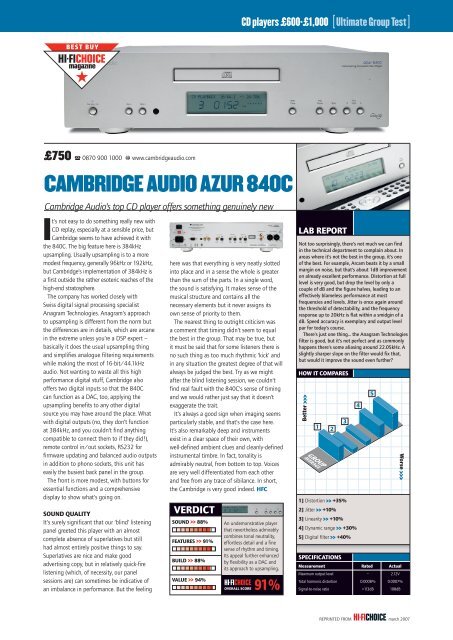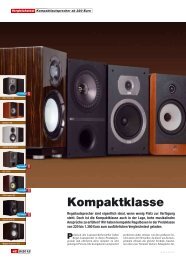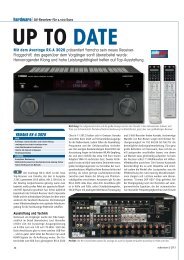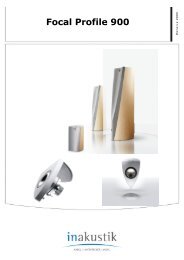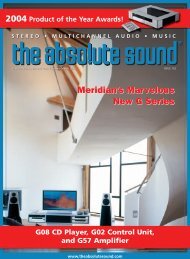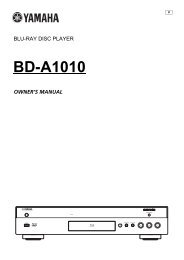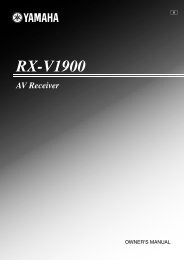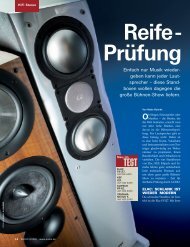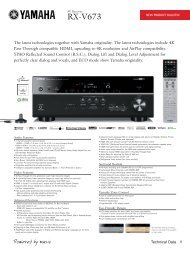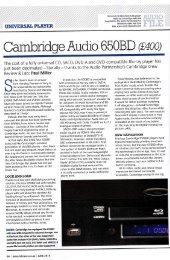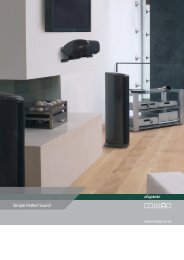CAMBRIDGE AUDIO AZUR 840C - EXCELIA HIFI
CAMBRIDGE AUDIO AZUR 840C - EXCELIA HIFI
CAMBRIDGE AUDIO AZUR 840C - EXCELIA HIFI
You also want an ePaper? Increase the reach of your titles
YUMPU automatically turns print PDFs into web optimized ePapers that Google loves.
£750 0870 900 1000 q www.cambridgeaudio.com<br />
<strong>CAMBRIDGE</strong> <strong>AUDIO</strong> <strong>AZUR</strong> <strong>840C</strong><br />
Cambridge Audio’s top CD player offers something genuinely new<br />
It’s not easy to do something really new with<br />
CD replay, especially at a sensible price, but<br />
Cambridge seems to have achieved it with<br />
the <strong>840C</strong>. The big feature here is 384kHz<br />
upsampling. Usually upsampling is to a more<br />
modest frequency, generally 96kHz or 192kHz,<br />
but Cambridge’s implementation of 384kHz is<br />
a first outside the rather esoteric reaches of the<br />
high-end stratosphere.<br />
The company has worked closely with<br />
Swiss digital signal processing specialist<br />
Anagram Technologies. Anagram’s approach<br />
to upsampling is different from the norm but<br />
the differences are in details, which are arcane<br />
in the extreme unless you’re a DSP expert –<br />
basically it does the usual upsampling thing<br />
and simplifies analogue filtering requirements<br />
while making the most of 16-bit/44.1kHz<br />
audio. Not wanting to waste all this high<br />
performance digital stuff, Cambridge also<br />
offers two digital inputs so that the <strong>840C</strong><br />
can function as a DAC, too, applying the<br />
upsampling benefits to any other digital<br />
source you may have around the place. What<br />
with digital outputs (no, they don’t function<br />
at 384kHz, and you couldn’t find anything<br />
compatible to connect them to if they did!),<br />
remote control in/out sockets, RS232 for<br />
firmware updating and balanced audio outputs<br />
in addition to phono sockets, this unit has<br />
easily the busiest back panel in the group.<br />
The front is more modest, with buttons for<br />
essential functions and a comprehensive<br />
display to show what’s going on.<br />
SOUND QUALITY<br />
It’s surely significant that our ‘blind’ listening<br />
panel greeted this player with an almost<br />
complete absence of superlatives but still<br />
had almost entirely positive things to say.<br />
Superlatives are nice and make good<br />
advertising copy, but in relatively quick-fire<br />
listening (which, of necessity, our panel<br />
sessions are) can sometimes be indicative of<br />
an imbalance in performance. But the feeling<br />
here was that everything is very neatly slotted<br />
into place and in a sense the whole is greater<br />
than the sum of the parts. In a single word,<br />
the sound is satisfying. It makes sense of the<br />
musical structure and contains all the<br />
necessary elements but it never assigns its<br />
own sense of priority to them.<br />
The nearest thing to outright criticism was<br />
a comment that timing didn’t seem to equal<br />
the best in the group. That may be true, but<br />
it must be said that for some listeners there is<br />
no such thing as too much rhythmic ‘kick’ and<br />
in any situation the greatest degree of that will<br />
always be judged the best. Try as we might<br />
after the blind listening session, we couldn’t<br />
find real fault with the <strong>840C</strong>’s sense of timing<br />
and we would rather just say that it doesn’t<br />
exaggerate the trait.<br />
It’s always a good sign when imaging seems<br />
particularly stable, and that’s the case here.<br />
It’s also remarkably deep and instruments<br />
exist in a clear space of their own, with<br />
well-defined ambient clues and cleanly-defined<br />
instrumental timbre. In fact, tonality is<br />
admirably neutral, from bottom to top. Voices<br />
are very well differentiated from each other<br />
and free from any trace of sibilance. In short,<br />
the Cambridge is very good indeed. HFC<br />
VERDICT<br />
SOUND >> 88%<br />
FEATURES >> 91%<br />
BUILD >> 88%<br />
VALUE >> 94%<br />
CD players £600-£1,000 [ Ultimate Group Test ]<br />
An undemonstrative player<br />
that nevertheless admirably<br />
combines tonal neutrality,<br />
effortless detail and a fine<br />
sense of rhythm and timing.<br />
Its appeal further enhanced<br />
by flexibility as a DAC and<br />
its approach to upsampling.<br />
OVERALL SCORE 91%<br />
LAB REPORT<br />
Not too surprisingly, there’s not much we can find<br />
in the technical department to complain about. In<br />
areas where it’s not the best in the group, it’s one<br />
of the best. For example, Arcam beats it by a small<br />
margin on noise, but that’s about 1dB improvement<br />
on already excellent performance. Distortion at full<br />
level is very good, but drop the level by only a<br />
couple of dB and the figure halves, leading to an<br />
effectively blameless performance at most<br />
frequencies and levels. Jitter is once again around<br />
the threshold of detectability, and the frequency<br />
response up to 20kHz is flat within a smidgin of a<br />
dB. Speed accuracy is exemplary and output level<br />
par for today’s course.<br />
There’s just one thing... the Anagram Technologies<br />
filter is good, but it’s not perfect and as commonly<br />
happens there’s some aliasing around 22.05kHz. A<br />
slightly sharper slope on the filter would fix that,<br />
but would it improve the sound even further?<br />
HOW IT COMPARES<br />
Better >>><br />
1<br />
2<br />
3<br />
1] Distortion >> +35%<br />
2] Jitter >> +10%<br />
3] Linearity >> +10%<br />
4] Dynamic range >> +30%<br />
5] Digital filter >> +40%<br />
SPECIFICATIONS<br />
Measurement Rated Actual<br />
Worse >>><br />
Maximum output level – 2.12V<br />
Total harmonic distortion 0.0008% 0.0007%<br />
Signal-to-noise ratio >113dB 108dB<br />
4<br />
REPRINTED FROM march 2007<br />
Untitled-4 1 14/2/07 14:46:30<br />
5
[ Ultimate Group Test ] CD players £600-£1,000<br />
CONCLUSIONS<br />
Each of these players has its own strengths and weaknesses – it’s all a matter of personal taste!<br />
We mentioned at the<br />
outset that this is a<br />
group with quite a<br />
narrow price, so it is perhaps easier<br />
than usual to compare product<br />
performance and value. Or it looks<br />
like that at first – there’s always a<br />
subjective fly in any easy-answer<br />
ointment. As so often happens,<br />
there’s no logically obvious<br />
pecking order among these<br />
players, because so much depends<br />
on the priorities of the individual<br />
listener – you!<br />
None of them is bad. They<br />
are all, as far as we can see,<br />
respectable, competent and<br />
AMPLIFIERS<br />
CREEK DESTINY £1,100<br />
A svelte but powerful amplifier, which<br />
adds high-end control and resolution.<br />
DENSEN BEAT B-150 £3,000<br />
Seriously upmarket as integrated amps<br />
go, with a strong bass.<br />
functional. This view we have<br />
reflected in the largely closely<br />
packed ratings, for which we make<br />
no apology. But none of them is<br />
perfect, which is why we entreat<br />
you to listen to as many of them<br />
as you can in order to see how<br />
their individual character suits<br />
your hearing. Our comments, lab<br />
findings and ratings will, we hope,<br />
assist you in flagging up areas of<br />
appeal, concern or interest.<br />
All that said, we did end up with<br />
a soft spot the size of Texas for the<br />
Cambridge Audio Azur <strong>840C</strong>.<br />
We’re most impressed by its<br />
combination of high technology,<br />
useful features (including digital<br />
inputs) and build quality, and it<br />
does offer some truly excellent<br />
sounds. One of its best features<br />
is that it does so without fuss or<br />
ostentation, and if you like<br />
show-off hi-fi you may not find it<br />
very exciting. But if you prefer<br />
listening to music, it’s got a very<br />
great deal to recommend it.<br />
Arcam, Naim and Quad are<br />
brands each with a strong ‘family<br />
theme’ but their players match that<br />
theme better visually, perhaps,<br />
than sonically. In fact, each has<br />
good and slightly disappointing<br />
features, with the Arcam warm and<br />
inviting but a touch behind on<br />
detail, the Naim great at tonal<br />
honesty and resolution but<br />
sometimes uncertain in the bass,<br />
and the Quad big and bold but<br />
less assured in quieter moments.<br />
We seem to have been a little less<br />
impressed by the valved models,<br />
though they differ considerably.<br />
The Vincent, indeed, has a lot<br />
to commend it in the way of<br />
‘traditional’ valve virtues – warmth,<br />
listenability and so forth – but the<br />
Astin Trew does seem to us to have<br />
some issues with the presence band<br />
and it didn’t quite hold our attention<br />
in the way the others did. HFC<br />
MAKE Arcam Astin Trew Cambridge Audio Naim Quad Vincent<br />
MODEL DiVA CD192 AT3000 Azur <strong>840C</strong> CD5i 99CD-S CD-S6<br />
KEY FEATURES<br />
TRY THEM WITH THESE<br />
CD PLAYERS AT A GLANCE<br />
LOUDSPEAKERS<br />
AVI NEUTRON IV £549<br />
Fine little speaker which puts out sound<br />
with more body than you might expect.<br />
DALI IKON 6 £899<br />
Cracking floorstander that delivers a<br />
detailed and entertaining sound.<br />
>> When auditioning players, be aware<br />
that output levels are not always<br />
perfectly matched: louder often sounds<br />
‘better’ in quick-fire demonstrations.<br />
>> CD players aren’t particularly<br />
microphonic, but any problems can be<br />
minimised by putting them out of the<br />
direct line of fire of the speakers.<br />
HINTS AND TIPS<br />
PRICE<br />
SOUND<br />
FEATURES<br />
BUILD<br />
VALUE<br />
OVERALL<br />
£875 £647 £750 £850 £650 £999<br />
CONCLUSION Offers a very comfortable Slight presence-band lift Undemonstrative, but Bass has great extension Revels in big music thanks Despite occasional lack of<br />
and involving sound, but makes for forward images combines neutrality, detail but slightly lacks control. to fearless presentation, bass precision and slightly<br />
resolution of details is not and less relaxed listening and timing. Enhanced by Tonal neutrality higher up but smaller-scale works limited image depth, gives<br />
always utterly searching. than some. Extended and flexibility as a DAC. is excellent, however. can lack focus.<br />
a good feeling of presence<br />
tuneful bass a plus.<br />
to the sound.<br />
ELEC DIG O/P Yes Yes Yes No No Yes<br />
OPT DIG O/P Yes No Yes No Yes No<br />
CD R-W Yes No Yes Yes Yes No<br />
CD TEXT Yes No No No No No<br />
>> Some players need a little warm-up<br />
time to sound at their best. If there’s a<br />
‘standby’ switch, use that instead of the<br />
mains switch – unless you’re sure you<br />
won’t be listening for a few days.<br />
>> If the option exists to switch off the<br />
display and any other circuits, take it.<br />
The sound may well improve a touch.<br />
BALANCED O/P No No Yes No Yes Yes<br />
LAB CONCLUSIONS E = EXCELLENT • G = GOOD • A = AVERAGE • P = POOR<br />
DISTORTION 0.001% G 0.025% A 0.0007% E 0.0015% G 0.002% G 0.0015% G<br />
JITTER


